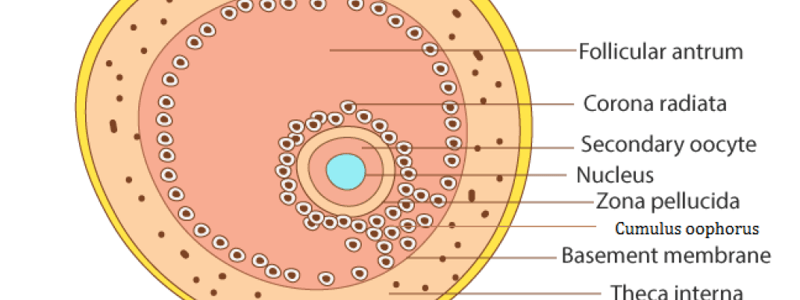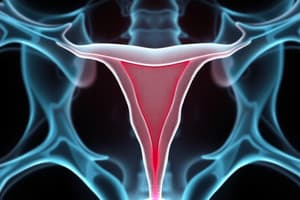Podcast
Questions and Answers
Mammals and ______ undergo internal fertilization.
Mammals and ______ undergo internal fertilization.
birds
Organisms that lay and hatch their eggs outside their body are called ______.
Organisms that lay and hatch their eggs outside their body are called ______.
oviparous
Ovoviviparous embryos do not have an internal connection to the mother’s ______.
Ovoviviparous embryos do not have an internal connection to the mother’s ______.
placenta
______ organisms directly nourish the developing embryos within the body.
______ organisms directly nourish the developing embryos within the body.
Examples of viviparous organisms include all ______ mammals.
Examples of viviparous organisms include all ______ mammals.
Reproduction in animals can either be sexual reproduction or ______ reproduction.
Reproduction in animals can either be sexual reproduction or ______ reproduction.
The sex cells of males are called ______ cells.
The sex cells of males are called ______ cells.
The fertilization process results in the formation of a ______.
The fertilization process results in the formation of a ______.
Sexual reproduction involves two parents, the male and the ______.
Sexual reproduction involves two parents, the male and the ______.
Some animals can undergo both sexual reproduction and ______ reproduction.
Some animals can undergo both sexual reproduction and ______ reproduction.
Gametes are the reproductive cells produced by ______ organisms.
Gametes are the reproductive cells produced by ______ organisms.
In some models of conception, live-bearing animals are represented using a plastic ______.
In some models of conception, live-bearing animals are represented using a plastic ______.
In asexual reproduction, organisms can reproduce using means other than the use of ______.
In asexual reproduction, organisms can reproduce using means other than the use of ______.
Oviparous animals lay their eggs in an ______ environment.
Oviparous animals lay their eggs in an ______ environment.
Viviparous animals nourish their young inside the mother's ______.
Viviparous animals nourish their young inside the mother's ______.
The source of nourishment for ovoviviparous animals is the ______ within the mother.
The source of nourishment for ovoviviparous animals is the ______ within the mother.
Fish and some reptiles are examples of ______ animals.
Fish and some reptiles are examples of ______ animals.
Most ______ are viviparous, meaning they give birth to live young.
Most ______ are viviparous, meaning they give birth to live young.
Birds are classified as ______ because they lay eggs.
Birds are classified as ______ because they lay eggs.
Male gametes are known as ______ cells.
Male gametes are known as ______ cells.
Female gametes are referred to as egg cells or ______.
Female gametes are referred to as egg cells or ______.
The granulosa cells serve to protect and nourish the ______.
The granulosa cells serve to protect and nourish the ______.
Sperm cells have enzymes contained within their ______ which aid in egg cell penetration.
Sperm cells have enzymes contained within their ______ which aid in egg cell penetration.
It takes multiple sperm to break down the zona pellucida but only one sperm to ______.
It takes multiple sperm to break down the zona pellucida but only one sperm to ______.
To prevent ______, steps are taken after fertilization to block additional sperm from entering the egg.
To prevent ______, steps are taken after fertilization to block additional sperm from entering the egg.
Fertilization that occurs outside the body of the animal is known as ______ fertilization.
Fertilization that occurs outside the body of the animal is known as ______ fertilization.
During external fertilization, both male and female animals release ______ and egg cells into the environment.
During external fertilization, both male and female animals release ______ and egg cells into the environment.
In internal fertilization, the zygote develops inside the ______ reproductive tract.
In internal fertilization, the zygote develops inside the ______ reproductive tract.
Amplexus is an example of a behavior seen in frogs during ______ fertilization.
Amplexus is an example of a behavior seen in frogs during ______ fertilization.
The production, development, and maturation of sperm cells happens within the male reproductive system through a process known as ______.
The production, development, and maturation of sperm cells happens within the male reproductive system through a process known as ______.
The primary sex hormone produced by the testes in male animals is called ______.
The primary sex hormone produced by the testes in male animals is called ______.
The male reproductive system is specialized for the production of ______ cells and their deposition into the female reproductive tract.
The male reproductive system is specialized for the production of ______ cells and their deposition into the female reproductive tract.
The male reproductive organs have a different function from that of ______ organs.
The male reproductive organs have a different function from that of ______ organs.
The function of depositing sperm into the female reproductive tract is crucial for successful ______.
The function of depositing sperm into the female reproductive tract is crucial for successful ______.
The pathway of a sperm cell begins in the ______ before it travels to deposit itself.
The pathway of a sperm cell begins in the ______ before it travels to deposit itself.
The male reproductive system has a series of structures that serve to perform its functions ______.
The male reproductive system has a series of structures that serve to perform its functions ______.
Hormones like testosterone signal the necessary changes and trigger ______ in males.
Hormones like testosterone signal the necessary changes and trigger ______ in males.
Cut the muscle of the abdomen ______ until the chest area.
Cut the muscle of the abdomen ______ until the chest area.
For the male frog, check the back body wall to locate two yellowish ______.
For the male frog, check the back body wall to locate two yellowish ______.
Sometimes black grains found inside the abdomen of a female frog are ______.
Sometimes black grains found inside the abdomen of a female frog are ______.
The fish gonads are located in the paired yellow or pink ______ in the lower part of the abdomen.
The fish gonads are located in the paired yellow or pink ______ in the lower part of the abdomen.
If the apron of a crab is pointed, the crab is ______.
If the apron of a crab is pointed, the crab is ______.
The ovaries of the female crab are located in the ______ structure.
The ovaries of the female crab are located in the ______ structure.
The male reproductive system includes the testis and the ______.
The male reproductive system includes the testis and the ______.
For waste disposal, place all dead animals in a black ______ bag.
For waste disposal, place all dead animals in a black ______ bag.
Flashcards
Sexual Reproduction
Sexual Reproduction
A type of reproduction involving two parents (male and female) to create offspring.
Gametes
Gametes
Reproductive cells (sperm and egg) produced by male and female parents.
Egg cells
Egg cells
Reproductive cells produced by the female parent.
Sperm cells
Sperm cells
Signup and view all the flashcards
Fertilization
Fertilization
Signup and view all the flashcards
Asexual Reproduction
Asexual Reproduction
Signup and view all the flashcards
Zygote
Zygote
Signup and view all the flashcards
Reproductive Systems of Animals
Reproductive Systems of Animals
Signup and view all the flashcards
Internal Fertilization
Internal Fertilization
Signup and view all the flashcards
Oviparous Development
Oviparous Development
Signup and view all the flashcards
Ovoviviparous Organisms
Ovoviviparous Organisms
Signup and view all the flashcards
Viviparous Organisms
Viviparous Organisms
Signup and view all the flashcards
Yolk
Yolk
Signup and view all the flashcards
Sperm penetration
Sperm penetration
Signup and view all the flashcards
Zona pellucida
Zona pellucida
Signup and view all the flashcards
Polyspermy
Polyspermy
Signup and view all the flashcards
Acrosome
Acrosome
Signup and view all the flashcards
Granulosa cells
Granulosa cells
Signup and view all the flashcards
Fusion of membranes
Fusion of membranes
Signup and view all the flashcards
Oviparous Reproduction
Oviparous Reproduction
Signup and view all the flashcards
Viviparous Reproduction
Viviparous Reproduction
Signup and view all the flashcards
Ovoviviparous Reproduction
Ovoviviparous Reproduction
Signup and view all the flashcards
Egg Cell
Egg Cell
Signup and view all the flashcards
Gonads
Gonads
Signup and view all the flashcards
How are tilapia gonads identified?
How are tilapia gonads identified?
Signup and view all the flashcards
Crab Gonads - Anterior Horn
Crab Gonads - Anterior Horn
Signup and view all the flashcards
Crab Gonads - Commissure
Crab Gonads - Commissure
Signup and view all the flashcards
Crab Gonads - Posterior Horn
Crab Gonads - Posterior Horn
Signup and view all the flashcards
Crab Gonads - Vas Deferens
Crab Gonads - Vas Deferens
Signup and view all the flashcards
Crab Gonads - Spermatheca
Crab Gonads - Spermatheca
Signup and view all the flashcards
Labia minora function
Labia minora function
Signup and view all the flashcards
Estrogen's role
Estrogen's role
Signup and view all the flashcards
Menstrual cycle
Menstrual cycle
Signup and view all the flashcards
Cervix as childbirth indicator
Cervix as childbirth indicator
Signup and view all the flashcards
Egg cell's journey during ovulation
Egg cell's journey during ovulation
Signup and view all the flashcards
Sperm cell production
Sperm cell production
Signup and view all the flashcards
Testosterone function
Testosterone function
Signup and view all the flashcards
Deposition of sperm
Deposition of sperm
Signup and view all the flashcards
Study Notes
Unit 13: The Reproductive System
- The reproductive system is crucial for species propagation.
- Reproduction can be sexual or asexual.
- Sexual reproduction involves male and female gametes, a process called fertilization.
- Asexual reproduction does not involve gametes.
Lesson 13.1: Sexual Reproduction In Animals
- Some animals have both sexual and asexual reproduction.
- Sexual reproduction requires two parents to produce reproductive cells (gametes).
- Key parts of the reproductive system are the male and female gonads, which are the testes and ovaries respectively.
- These gonads produce the gametes sperm and egg cells.
Lesson 13.2: The Female Reproductive System
- The female reproductive system has organs that perform specific functions.
- Essential functions include egg production, fertilization, and zygote development.
- The system is composed of internal organs like the vagina, uterus, fallopian tubes, and ovaries.
- The vagina is an elastic muscular canal.
- The uterus is responsible for receiving the fertilized egg and allowing it to grow.
- The fallopian tubes transport the egg to the uterus.
- Ovaries store immature eggs until ovulation, a release process.
- Puberty is when the ovaries start to produce eggs.
- The pH of the vagina is acidic, which helps protect against pathogens like bacteria.
Lesson 13.3: The Male Reproductive System
- Male reproductive organs have different functions compared to the female system.
- These organs include testes, scrotum, urethra, penis, and sperm ducts.
- The testes produce sperm cells and testosterone.
- The scrotum maintains temperature for sperm production.
- The urethra is a tube that transports urine and sperm outside the body.
- The penis is the external organ used for sperm deposition.
- Sperm is produced in the seminiferous tubules inside the testes.
Lesson 13.4: Spermatogenesis and Oogenesis
- Spermatogenesis is the process of sperm cell production in males.
- Oogenesis is the process of egg cell production in females.
- Both involve meiosis, a type of cell division.
- Spermatogenesis occurs in the testes and results in four sperm cells from a single spermatogonium cell.
- Oogenesis occurs in the ovaries and produces one functional egg cell and three polar bodies from a single oogonium cell.
- Gametogenesis encompasses the sperm and egg production, starting from stem cells and ending with the mature gamete.
Studying That Suits You
Use AI to generate personalized quizzes and flashcards to suit your learning preferences.




